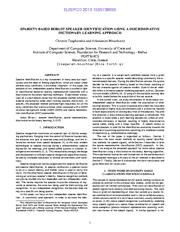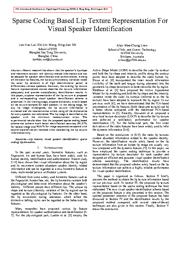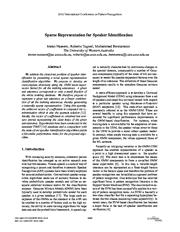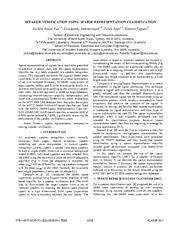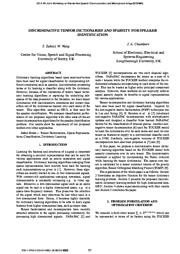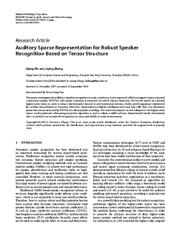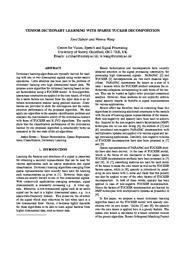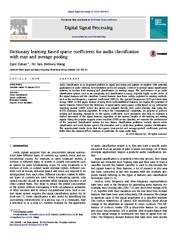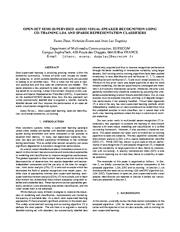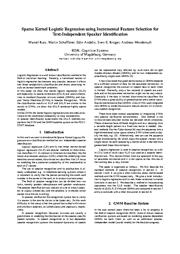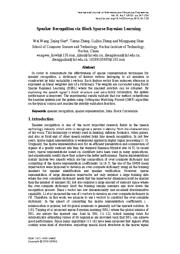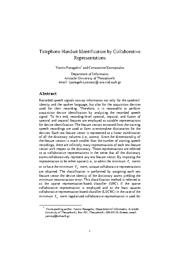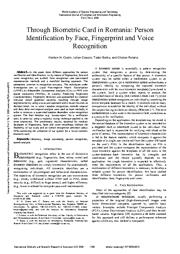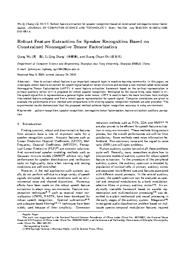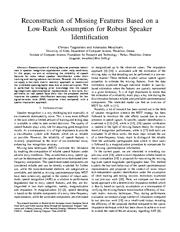A copy of this work was available on the public web and has been preserved in the Wayback Machine. The capture dates from 2018; you can also visit the original URL.
The file type is application/pdf.
Filters
Sparsity Based Robust Speaker Identification Using A Discriminative Dictionary Learning Approach
2013
Zenodo
As a result, the discriminative sparse-code error promotes (class) label consistency in the new (transformed) sparse codes by enforcing the features from the same speaker to have similar sparse representation ...
Moreover, the sparse codes feature extraction is followed by sparse discriminant analysis to perform speaker recognition in [11] , while in [12] SRC is used for the same task using GMM mean supervectors ...
doi:10.5281/zenodo.43348
fatcat:hoplxqvdtjgvdfilllr2vccoxe
Sparse coding based lip texture representation for visual speaker identification
2014
2014 19th International Conference on Digital Signal Processing
In this paper, a sparse representation of the lip texture is proposed and a corresponding visual speaker identification scheme is presented. ...
However, the existing lip texture feature representations cannot describe the texture information adequately and provide unsatisfactory identification results. ...
Academy of Sciences, and Key Lab of Information Network Security, Ministry of Public Security. ...
doi:10.1109/icdsp.2014.6900736
dblp:conf/icdsp/LaiWSL14
fatcat:yljwsdjixnejpmnvhhswqdvjsy
Sparse Representation for Speaker Identification
2010
2010 20th International Conference on Pattern Recognition
We address the closed-set problem of speaker identification by presenting a novel sparse representation classification algorithm. ...
Experiments have been conducted on the standard TIMIT [14] database and a comparison with the state-of-art speaker identification algorithms yields a favorable performance index for the proposed algorithm ...
We exploit this discriminative nature of sparse representation to propose a novel speaker identification algorithm. ...
doi:10.1109/icpr.2010.1083
dblp:conf/icpr/NaseemTB10a
fatcat:tfcaax7zhravlav6mxph5iw7ji
Speaker verification using sparse representation classification
2011
2011 IEEE International Conference on Acoustics, Speech and Signal Processing (ICASSP)
Sparse representations of signals have received a great deal of attention in recent years, and the sparse representation classifier has very lately appeared in a speaker recognition system. ...
This approach represents the (sparse) GMM mean supervector of an unknown speaker as a linear combination of an over-complete dictionary of GMM supervectors of many speaker models, and 1 -norm minimization ...
Their experiments were conducted using the TIMIT database and they found that speaker identification using a sparse representation classifier showed good performance compared with GMM-SVM speaker identification ...
doi:10.1109/icassp.2011.5947366
dblp:conf/icassp/KuaAET11
fatcat:r5yz2owa6rb53d754r4yvpcy3i
Discriminativetensor dictionaries and sparsity for speaker identification
2014
2014 4th Joint Workshop on Hands-free Speech Communication and Microphone Arrays (HSCMA)
This algorithm, named as GT-D, is then used for the speaker identification. ...
We compare classification performance of our proposed algorithm with other state-of-the-art tensor decomposition algorithms for the speaker identification problem. ...
Dictionary learning algorithms emerging from sparse representations have recently been used for learning such representations as given in [1] . ...
doi:10.1109/hscma.2014.6843247
dblp:conf/hscma/ZubairWC14
fatcat:jx2w6llgsfhs7loefb3rxhpzfu
Auditory Sparse Representation for Robust Speaker Recognition Based on Tensor Structure
2008
EURASIP Journal on Audio, Speech, and Music Processing
Firstly, speech signals are represented by cochlear feature based on frequency selectivity characteristics at basilar membrane and inner hair cells; then, low-dimension sparse features are extracted by ...
We encode speech as a general higher-order tensor in order to extract discriminative features in spectrotemporal domain. ...
sparse tensor representation for robust speaker modeling. ...
doi:10.1155/2008/578612
fatcat:uzzdspgw4fad3ezmg7rhai5c2u
Tensor dictionary learning with sparse TUCKER decomposition
2013
2013 18th International Conference on Digital Signal Processing (DSP)
We also apply our algorithm to the speaker identification problem and compare the discriminative ability of the dictionaries learned with those of TUCKER and K-SVD algorithms. ...
In this algorithm, sparseness constraints are applied to the core tensor, of which the n-mode factors are learned from the input data in an alternate minimization manner using gradient descent. ...
Speaker Identification To compare the discriminative power of our proposed algorithm, we apply it for the multi-class classification problem of speaker identification and compare its classification performance ...
doi:10.1109/icdsp.2013.6622725
dblp:conf/icdsp/ZubairW13
fatcat:snq75pzcljeddovvgdwbscfc4m
Dictionary learning based sparse coefficients for audio classification with max and average pooling
2013
Digital signal processing (Print)
and male-female speech discrimination and a multi-class problem, speaker identification. ...
In this paper, instead of using these well-established features, we explore the potential of sparse features, derived from the dictionary of signal atoms using sparse coding based on e.g. orthogonal matching ...
numbers EP/H050000/1 and EP/H012842/1). ...
doi:10.1016/j.dsp.2013.01.004
fatcat:fwrfmifjsvfwpfll4zezpgwese
Open-set semi-supervised audio-visual speaker recognition using co-training LDA and Sparse Representation Classifiers
2013
2013 IEEE International Conference on Acoustics, Speech and Signal Processing
This paper proposes a new approach to open-set, semi-supervised learning based on co-training, Linear Discriminant Analysis (LDA) subspaces and Sparse Representation Classifiers (SRCs). ...
This is often not the case in realistic applications and thus open-set alternatives are needed. ...
The new algorithm combines linear discriminant analysis (LDA) with a sparse representation classifier (SRC) [?] . While SRC has shown to give state-of-the-art performance in face recognition [?] ...
doi:10.1109/icassp.2013.6638208
dblp:conf/icassp/ZhaoED13
fatcat:fhgn25jglrhslnlhts2vvcnspi
Sparse Kernel Logistic Regression using Incremental Feature Selection for Text-Independent Speaker Identification
2006
2006 IEEE Odyssey - The Speaker and Language Recognition Workshop
In speaker identification experiments the SKLR methods outperform the SVM and the GMM baseline system on the POLY-COST database. ...
In this paper we show that kernel logistic regression (KLR) and especially its sparse extensions (SKLR) are useful alternatives to standard Gaussian mixture models (GMMs) and Support Vector Machines (SVMs ...
Figure 1 : 1 Sparseness (%) of the discriminative classifiers using different amounts of training data. ...
doi:10.1109/odyssey.2006.248115
dblp:conf/odyssey/KatzSAKW06
fatcat:rmrjc7ciujfwvjwc2xosg2eqhq
Speaker Recognition via Block Sparse Bayesian Learning
2015
International Journal of Multimedia and Ubiquitous Engineering
In order to demonstrate the effectiveness of sparse representation techniques for speaker recognition, a dictionary of feature vectors belonging to all speakers is constructed by total variability i-vectors ...
The weights are calculated using Block Sparse Bayesian Learning (BSBL) where the sparsest solution can be obtained. ...
In [6] [7] , the use of the GMM mean supervectors were proposed to develop an over-complete dictionary using all the training speakers for speaker identification and speaker verification. ...
doi:10.14257/ijmue.2015.10.7.26
fatcat:ny23nd5tivaonn6fdcz5v475l4
Telephone Handset Identification by Collaborative Representations
2013
International Journal of Digital Crime and Forensics
To this end, recording-level spectral, cepstral, and fusion of spectral and cepstral features are employed as suitable representations for device identification. ...
Recorded speech signals convey information not only for the speakers' identity and the spoken language, but also for the acquisition devices used for their recording. ...
Panagakis has been co-financed by the European Union (European Social Fund -ESF) and Greek national funds through the Operational Program "Education and Lifelong Learning" of the National Strategic Reference ...
doi:10.4018/ijdcf.2013100101
fatcat:6e3mvj44ibftfpbqochzzou534
Through Biometric Card In Romania: Person Identification By Face, Fingerprint And Voice Recognition
2008
Zenodo
Face recognition uses parts-based representation methods and a manifold learning approach. The assessment criterion is recognition accuracy. ...
As to voice / speaker recognition, melodic cepstral and delta delta mel cepstral analysis were used as main methods, in order to construct a supervised speaker-dependent voice recognition system. ...
Speech Feature Extraction The Mel Frequency Cepstral Coefficients (MFCC) are the dominant features used for speech and speaker recognition [20] . ...
doi:10.5281/zenodo.1071629
fatcat:tlmrpussunbnddfnzm3auoufae
Robust Feature Extraction for Speaker Recognition Based on Constrained Nonnegative Tensor Factorization
2010
Journal of Computer Science and Technology
and find a robust sparse representation for speech signal. ...
A novel feature extraction framework based on the cortical representation in primary auditory cortex (A1) is proposed for robust speaker recognition. ...
The CTCC is used as feature representation for speaker recognition in this paper. Finally, GMM is employed to perform speaker modeling and recognition. ...
doi:10.1007/s11390-010-9365-6
fatcat:6h4wzfjq7ng6no3477k6e7yac4
Reconstruction of missing features based on a low-rank assumption for robust speaker identification
2014
IISA 2014, The 5th International Conference on Information, Intelligence, Systems and Applications
In this paper, we aim at enhancing the reliability of speech features for noise robust speaker identification under short training and testing sessions restrictions. ...
Experiments on real speech data show that the proposed method improves the speaker identification accuracy especially for low signal-to-noise ratio (SNR) scenarios when compared with a sparse imputation ...
The focus is given on estimating reliable speech features further used for speaker identification under noisy conditions. ...
doi:10.1109/iisa.2014.6878778
dblp:conf/iisa/TzagkarakisM14
fatcat:i5xpnewdarfpxczgbqk3d2ncwi
« Previous
Showing results 1 — 15 out of 6,957 results

